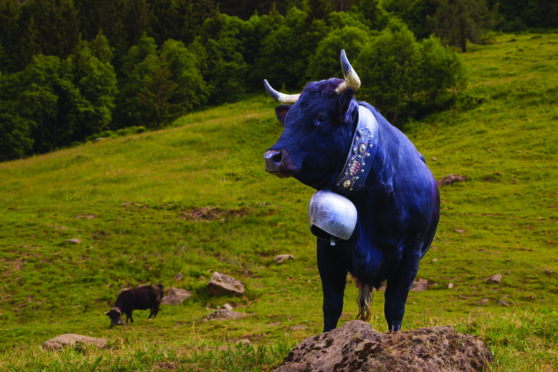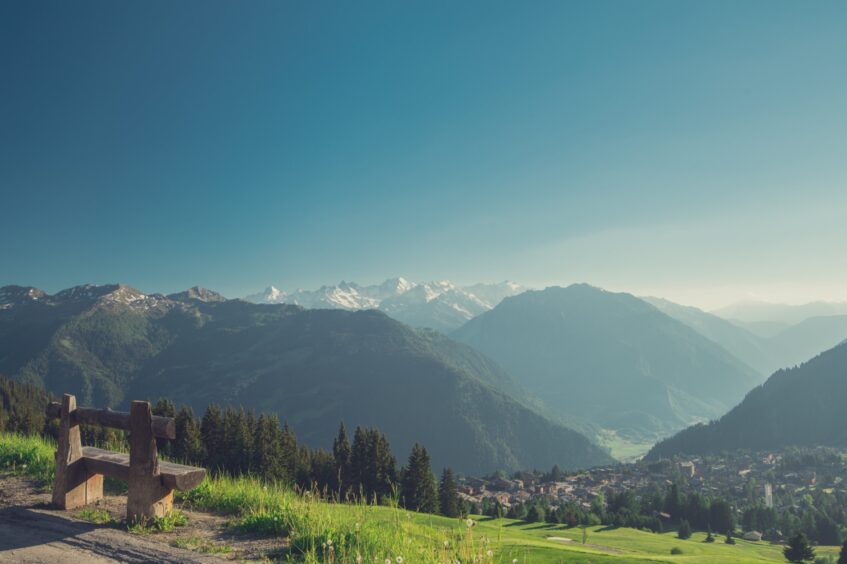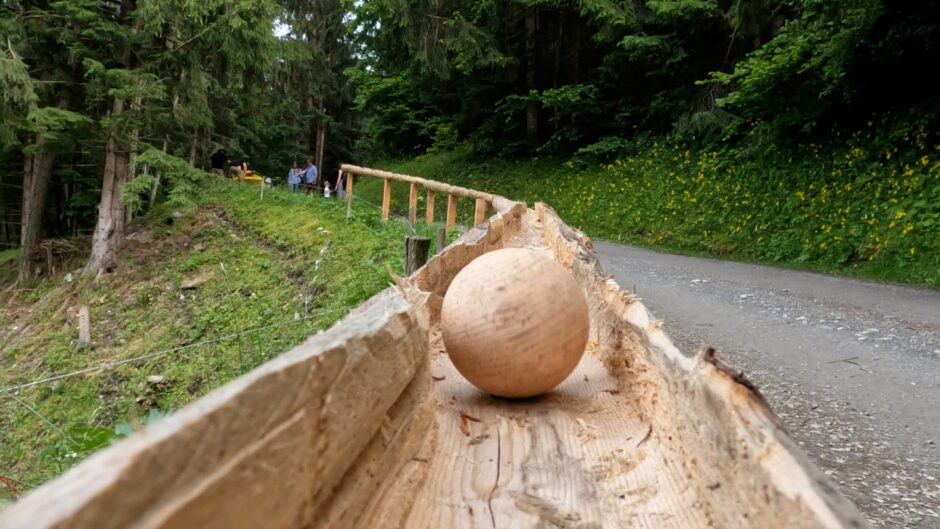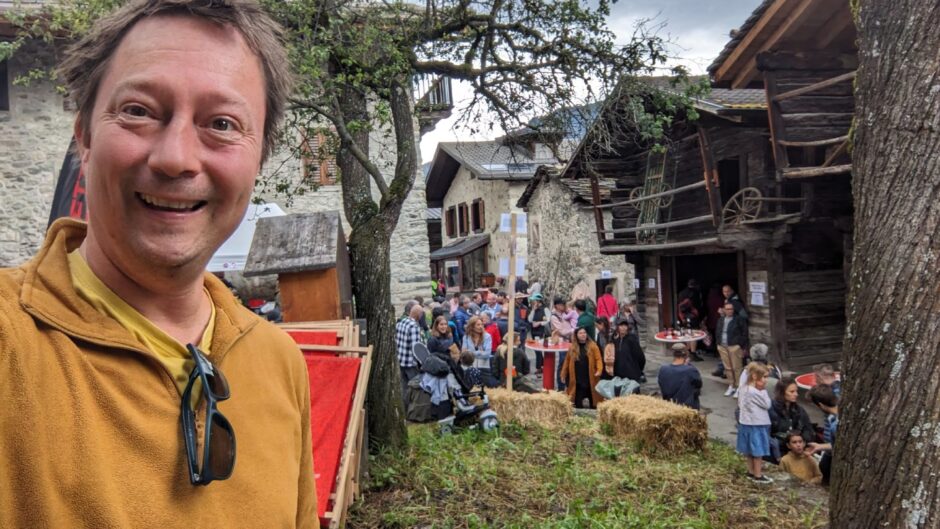
The cow known as Number 54 tilts her head, lets out long, guttural “mooo,” and heads directly up the mountain. She has quite clearly had enough of standing in the Alpine drizzle and is ready to get a bit of grub in the cowshed above.
Her cow bell jangles as she climbs, adding to the cacophony of a hundred of her brethren who are performing a mix of mooing, eating, staring and, err, fighting below.
The Heren’s cow, a breed unique to the Val d’Hérens valley in the Valais canton of Switzerland, are known as the fighting cow for their propensity to test their strength by locking horns with each other.
A thin piece of rope is all that stands between me and a bovine brawl. Welcome to the unvarnished version of Swiss farming life, Verbier style.
I’m relieved to find that instead of a raucous fight, it’s more a case of a pushing match as and when any individual cow seems interested in a bit of a wrestle. Around me dozens of locals eagerly jot down notes on clipboards of their favourite cow, or who won a particular test of strength. Some bring their kids to watch, others a bottle of wine and some plastic cups. The cows stare quizzically back at the onlookers.
“It is in the DNA of the Heren cattle breed to fight,” says Verbier Tourism’s Elise Farquet, who grew up in the valley. “As soon as they are calves they are already pushing their heads against each other to see who is stronger, so in this specific breed it is really important form them. They come here in the beginning of June with all the different owners of the breeds, who take them onto the Alpine pastures.”
Each year the valley’s herds vie to establish a sort of bovine alpine matriarchy, and crown one the “Queen of the Alps”. The Swiss have seemingly done so in the same valley since at least 1574, when a local monastery penned the first written record of the tradition.
Traditional Apine farming has co-existed quietly alongside the glitzy world of freeride skiing and snowboarding which has made Verbier and the surrounding valley world famous. A new initiative aims to help the local farming community emerge from the shadow of their sporty compatriots and establish the region as a mecca for adventure-seekers who also have a taste for high-quality local food.
“Even when you live here, everyone is always in a hurry and you stop at a big supermarket to buy products,” says Martine Jacques-Dufour, coordinator from Grande Entremont, an organisation set up to promote Swiss producers. “But they realise that they have lots of producers even in their own village. People are more and more aware of the diversity and richness of local products, and are happy to try them and not buy standardised products.”
Key to this plan is the inaugural pan-Alpine food festival, the Grand Marché des Terroirs Alpins market held in the village of Bruson in June. If Verbier can be considered the king of the Alpine ski resorts then Bruson is notable for almost the exact opposite of its high-octane neighbour. The village retains the charm of a traditional alpine village, with winding narrow streets lined by timber-framed homes, all seemingly as old as the mountain’s themselves. Cars have been banned for the weekend and throngs of locals have taken over the streets to eat, drink and be merry with specialities from Switzerland, Italy, France, Slovenia and beyond.
For families, the village built an indoor adventure room in one of the buildings. For a few Swiss franc’s festivalgoers can also purchase a wooden ball and play a game of Rouli Bouli, where you follow said ball as it travels through different courses on a walk down the mountain.
It seems that the game has been designed for children – and competitive journalists – to enjoy. A five-year-old screeches in delight as her wooden ball descends with a clang through a series of pots and pans. Another runs through a maze of wooden pipes.
For children, it seems like the ideal way to distract them from the exercise of a long walk home. For others, it was a way to burn off the calories of a hearty festival as you descend into Le Chable.
The food and the adrenaline sports also mix easily. A group of mountain-biker’s stop by the festival as they make their way down the mountain. Paraglider’s circle on the thermals in the sky above.
For 3CHF, around £2.60, I sample a glass of Italian red from a makeshift bar setup in a stable. Across the road, Switzerland’s most famous raclette chef is busy slicing molten cheese, smiling for selfies and giving tuition in the perfect way to carve the Swiss delicacy.
Alpine farmers seem to have specialised in finding any herb they could and making a concoction from it as alcoholic as possible. The spiritual posterboy of the Valais is an absinthe from the nearby village of Sarrayer, which comes with an alcohol volume of 69%.
Keen for me to taste the local brew, a stallholder pours the absinthe into a glass, followed by water filtered through a sugar cube to dilute the spirit. As the greenish liquid turns a paler hue, she indicates it’s time to drink.
The taster confirms that the absinthe is indeed as potent as I remember it. I say thanks and purchase some cheese instead.
Luckily the beer tasting session was a little more palatable.
“We are going to start with a beer with little aroma, and we are going to continue with more and more aroma,” says zythologist Carole Beal.
Zythology is the study of beer and science and Beal caught the passion for discovering and sharing the art of brewing, beer and its history while studying in Paris.
A Swiss male voice choir makes their entrance just as we begin savouring our third IPA. Beal has to strain her voice to explain the mix of hops and local grain in the ale – undimmed by having to compete with the choral backing singers. It’s 3pm and there’s still a wine-tasting session to come before the festival truly gets going.
I catch myself thinking, “Is this a setup? What next, a lederhosen-clad dance troupe?” Amid the smoke, cheese, wine, music and sunshine halfway up a mountain I realise it’s just the Swiss doing what the Swiss do best.
In a world where ever more people are chasing “authentic” experiences Bruson manages to make it look effortless. The only question is just what to try next.
P.S. The Herens (Eringer in German) is a breed of cattle named after the Val d’Hérens region of Switzerland. These small, horned alpine cattle are coloured black, brown or dark red, often with a lighter stripe along the spine. The cows are used in organised cow fights.
Factfile
Bruson’s Great Alpine Terrier Market runs in June each year, the PALP festival holds events throughout the summer from late May to October. For more info visit: https://palpfestival.ch/en/
A three-night stay at Hôtel du Giétroz is priced from £104 per night, based on two people sharing. Breakfast included. Direct flights from London Heathrow to Geneva cost from £72pp with Swiss one-way

Enjoy the convenience of having The Sunday Post delivered as a digital ePaper straight to your smartphone, tablet or computer.
Subscribe for only £5.49 a month and enjoy all the benefits of the printed paper as a digital replica.
Subscribe © Shutterstock / Ekaterina Grivet
© Shutterstock / Ekaterina Grivet
